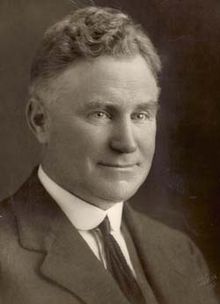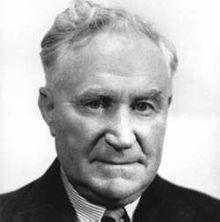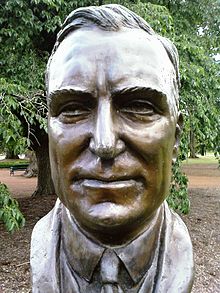- Earle Page
-
The Right Honourable
Sir Earle Page
GCMG, CH
11th Prime Minister of Australia In office
7 April – 26 April 1939Monarch George VI Governor General Alexander Hore-Ruthven Preceded by Joseph Lyons Succeeded by Robert Menzies Constituency Cowper (New South Wales) Personal details Born 8 August 1880
Grafton, New South Wales, AustraliaDied 20 December 1961 (aged 81)
Sydney, New South Wales, AustraliaPolitical party Country Spouse(s) Ethel Blunt Children 5 Alma mater University of Sydney Religion Methodism Sir Earle Christmas Grafton Page, GCMG, CH (8 August 1880 – 20 December 1961) was the 11th Prime Minister of Australia, and is to date the second-longest serving federal parliamentarian in Australian history, with 41 years, 361 days in Parliament.[1]
Contents
Early life
Born in Grafton, New South Wales, Page was educated at Sydney Boys High School and the University of Sydney, where he graduated in medicine at the top of his year in 1901. He worked at Sydney's Royal Prince Alfred Hospital, where he met Ethel Blunt, a nurse, whom he married in 1906. In 1903 he joined a private practice in Grafton and in 1904 he became one of the first people in the country to own a car.[2] He practised in Sydney and Grafton before joining the Australian Army as a medical officer in the First World War, serving in Egypt. After the war he went into farming and was elected Mayor of Grafton.[3]
Political career
In 1919 Page was elected to the House of Representatives from Cowper in northeastern New South Wales. He ran as a candidate of the Farmers and Settlers Association of New South Wales, which in 1920 merged with several other rural-based parties to form the Country Party. He became the party's leader in 1921, ousting William McWilliams. Dislike of the Hughes government's rural policies was one of the reasons the Country Party was formed, and when the party won the balance of power in the House at the 1922 election, Page demanded and got Hughes's resignation as the price for supporting the Nationalist government.[4]
Page then began negotiations with Hughes' successor as leader of the Nationalists, Stanley Bruce. His terms were stiff; he wanted his Country Party to have five seats in an 11-man Cabinet, including the post of Treasurer and the second rank in the ministry for himself. These demands were unprecedented for such a new party. Nonetheless, as the Country Party was the Nationalists' only realistic coalition partner, Bruce accepted Page's terms.[4][5] For all intents and purposes, Page was the first Deputy Prime Minister of Australia (a title that did not officially exist until 1968). Since then, the leader of the Country/National Party has been the second-ranking member in nearly every non-Labor government.
Page continued his professional medical practice, and on 22 October 1924 he had to tell his best friend, Thomas Shorten Cole, the news that his wife Mary Ann Crane had just died on the operating table from complications of intestinal or stomach cancer – reputed by their daughter Dorothy May Cole to be "the worst day of his life".[citation needed]
He was a strong believer in orthodox finance and conservative policies, except where the welfare of farmers was concerned: then he was happy to see government money spent freely. He was also a "high protectionist": a supporter of high tariff barriers to protect Australian rural industries.[5][6]
The Bruce-Page government was defeated by Labor in 1929 (with Bruce losing his own seat), and Page went into opposition. In 1931 Joseph Lyons was able to form a UAP government without Country Party support. In 1934, however, the coalition was re-formed, and Page became Minister for Commerce. He was made a Knight Grand Cross of the Order of St Michael and St George (GCMG) in the New Year’s Day Honours of 1938.[7]
Prime Minister
When Lyons died suddenly in 1939, the Governor-General Lord Gowrie appointed Sir Earle Page caretaker Prime Minister. He held the office for three weeks until the UAP elected a new leader.[8] While ten Australian Prime Ministers were knighted (and Bruce was elevated to the peerage), Page is the only one who was knighted before becoming Prime Minister.
Page had been very close to Lyons, but he disliked Lyons's deputy, Robert Menzies, whom he charged publicly with having been disloyal to Lyons. When Menzies was elected UAP leader, Page refused to serve under him, and made an extraordinary personal attack on him in the House, accusing him not only of ministerial incompetence but of physical cowardice (for failing to enlist during World War I). His party soon rebelled, though, and Page was deposed as Country Party leader and replaced by Archie Cameron.[5]
In 1940 Page and Menzies patched up their differences for the sake of the war effort, and Page returned to the Cabinet as Minister for Commerce.[5] Nevertheless, Page's accusations were not forgotten and were occasionally raised in parliament by Menzies' opponents (notably Eddie Ward). In 1941, the government fell; and Page spent the eight years of the Curtin and Chifley Labor governments on the opposition backbench.[9] He was made a Companion of Honour (CH) in June 1942.[10]
New states
In 1949 Page put forward a discussion paper on the redrawing of state boundaries: Australia would be divided into twelve states, Queensland into four, Eden-Monaro and East Gippsland would become another state, Mount Gambier to Mildura and Cape Otway another state, and the Northern Territory divided into two.[11]
Return to the ministry
Menzies returned to the Prime Ministership in 1949, and Page was made Minister for Health. He held this post until 1956, when he was 76, then retired to the backbench.[12]
On Billy Hughes' death in October 1952, Page became the Father of the House of Representatives and Father of the Parliament.
Later life and death
Page was the first Chancellor of the University of New England, which was established in 1954.[12] In 1959 Page married his secretary Jean Thomas. [13] Refusing to consider retirement from Parliament – even at the 1961 election, when he was 81, suffering from lung cancer and too sick to campaign – Page soldiered on. In one of the great electoral upsets of Australian history, he lost his seat to Labor challenger Frank McGuren, whom he'd defeated soundly in 1958. He had become comatose before the election, never regained consciousness, and died a few days later at Royal Prince Alfred Hospital without ever knowing that he had been defeated.[5][14]
Page represented Cowper for just four days short of 42 years, making him the longest serving Australian federal parliamentarian who represented the same seat throughout his career. Only Billy Hughes served in Parliament longer than Page; but Hughes represented four different electorates in New South Wales and Victoria.
His grandson Don Page is currently a National MP in the NSW Parliament and served as Deputy Leader of the NSW Nationals from 2003 to 2007.
Jean Page died 20 June 2011 [15]
Honours
The Canberra suburb of Page is named after him, as is the House of Representatives Division of Page.
Earle Page College, a residential college of the University of New England, was founded in his honour, and is the venue for the Earle Page Annual Politics Dinner, which has had numerous prominent national and international guest lecturers.
In 1957, a new building at Royal Prince Alfred Hospital was opened by Page and named the Page Chest Pavilion.
In 1975 he was honoured on a postage stamp bearing his portrait issued by Australia Post.[16]
See also
Notes
- ^ Davey, Paul. "Our history of achievement". The Nationals. Archived from the original on 22 October 2007. http://web.archive.org/web/20071022220725/http://www.nationals.org.au/About/history.asp. Retrieved 9 November 2007.
- ^ "Earle Page, Early years". Australia's Prime Ministers. National Archives of Australia. http://primeministers.naa.gov.au/primeministers/page/before-office.aspx#section1. Retrieved 19 March 2010.
- ^ "Earle Page, South Grafton Council 1913–19". Australia's Prime Ministers. National Archives of Australia. http://primeministers.naa.gov.au/primeministers/page/before-office.aspx#section2. Retrieved 19 March 2010.
- ^ a b "Earle Page, Member for Cowper 1919". Australia's Prime Ministers. National Archives of Australia. http://primeministers.naa.gov.au/primeministers/page/before-office.aspx#section3. Retrieved 19 March 2010.
- ^ a b c d e Bridge, Carl (1988). "Page, Sir Earle Christmas Grafton (1880–1961)". Australian Dictionary of Biography. Canberra: Australian National University. http://www.adb.online.anu.edu.au/biogs/A110127b.htm. Retrieved 19 March 2010.
- ^ "Earle Page, Deputy Prime Minister 1923–29". Australia's Prime Ministers. National Archives of Australia. http://primeministers.naa.gov.au/primeministers/page/before-office.aspx#section4. Retrieved 19 March 2010.
- ^ "It’s an Honour – GCMG". Itsanhonour.gov.au. 1938-01-01. http://www.itsanhonour.gov.au/honours/honour_roll/search.cfm?aus_award_id=1073808&search_type=simple&showInd=true. Retrieved 2011-11-04.
- ^ "Earle Page, In office". Australia's Prime Ministers. National Archives of Australia. http://primeministers.naa.gov.au/primeministers/page/in-office.aspx. Retrieved 19 March 2010.
- ^ "Earle Page, In Opposition 1941–49". Australia's Prime Ministers. National Archives of Australia. http://primeministers.naa.gov.au/primeministers/page/after-office.aspx#section3. Retrieved 19 March 2010.
- ^ "It’s an Honour – CH". Itsanhonour.gov.au. 1942-06-26. http://www.itsanhonour.gov.au/honours/honour_roll/search.cfm?aus_award_id=1065988&search_type=simple&showInd=true. Retrieved 2011-11-04.
- ^ Horsham Times 18 Aug 1949
- ^ a b "Earle Page, Minister for Health 1949–56". Australia's Prime Ministers. National Archives of Australia. http://primeministers.naa.gov.au/primeministers/page/after-office.aspx#section4. Retrieved 19 March 2010.
- ^ Bridge, Carl. "Biography - Sir Earle Christmas Grafton Page - Australian Dictionary of Biography". Adb.anu.edu.au. http://adb.anu.edu.au/biography/page-sir-earle-christmas-grafton-7941. Retrieved 2011-11-04.
- ^ "Earle Page, Backbencher 1956–61". Australia's Prime Ministers. National Archives of Australia. http://primeministers.naa.gov.au/primeministers/page/after-office.aspx#section5. Retrieved 19 March 2010.
- ^ Sydney Morning Herald 9 July 2011
- ^ "Australian postage stamp". Australian Stamp and Coin Company. http://www.australianstamp.com/images/large/0011150.jpg. Retrieved 16 February 2010.
Further reading
- Hughes, Colin A (1976), Mr Prime Minister. Australian Prime Ministers 1901–1972, Oxford University Press, Melbourne, Victoria, Ch.12. ISBN 0-19-550471-2
References
- "Earle Page". Australia's Prime Ministers. National Archives of Australia. http://primeministers.naa.gov.au/primeministers/page/. Retrieved 19 March 2010.
- "Earle Page". National Museum of Australia. http://www.nma.gov.au/education/school_resources/websites_and_interactives/primeministers/earle_page/. Retrieved 19 March 2010.
- Bridge, Carl (1988). "Page, Sir Earle Christmas Grafton (1880–1961)". Australian Dictionary of Biography. Canberra: Australian National University. http://adb.anu.edu.au/biography/page-sir-earle-christmas-grafton-7941. Retrieved 19 March 2010.
External links
Parliament of Australia Preceded by
John ThomsonMember for Cowper
1919–1961Succeeded by
Frank McGurenPreceded by
Billy HughesFather of the House of Representatives
1952–1961Succeeded by
Eddie WardFather of the Parliament
1952–1961Party political offices New political party Leader of the Country Party
1922–1939Succeeded by
Archie CameronPolitical offices Preceded by
Stanley BruceTreasurer of Australia
1923–1929Succeeded by
E G TheodorePreceded by
Frederick StewartMinister for Commerce
1934–1939Succeeded by
George McLeayPreceded by
Billy HughesMinister for Health
1937–1938Succeeded by
Harry FollPreceded by
Joseph LyonsPrime Minister of Australia
1939Succeeded by
Robert MenziesPreceded by
Archie CameronMinister for Commerce
1940–1941Succeeded by
William ScullyPreceded by
Nick McKennaMinister for Health
1949–1956Succeeded by
Donald CameronAcademic offices New title Chancellor of the University of New England
1954–1960Succeeded by
Phillip WrightPrime Ministers of Australia Leaders of the National Party of Australia (formerly Country Party) Categories:- Prime Ministers of Australia
- Australian monarchists
- Treasurers of Australia
- Members of the Cabinet of Australia
- Members of the Australian House of Representatives for Cowper
- Members of the Australian House of Representatives
- National Party of Australia politicians
- Knights Commander of the Order of St Michael and St George
- Australian knights
- Members of the Order of the Companions of Honour
- People from Grafton, New South Wales
- 1880 births
- 1961 deaths
- People educated at Sydney Boys High School
Wikimedia Foundation. 2010.


